
Maple syrup is a syrup made from the sap of maple trees. In cold climates, these trees store starch in their trunks and roots before winter; the starch is then converted to sugar that rises in the sap in late winter and early spring. Maple trees are tapped by drilling holes into their trunks and collecting the sap, which is processed by heating to evaporate much of the water, leaving the concentrated syrup.
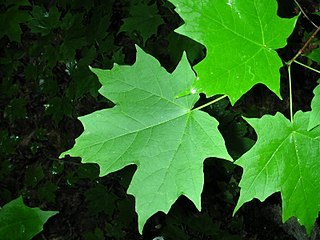
Acer saccharum, the sugar maple, is a species of flowering plant in the soapberry and lychee family Sapindaceae. It is native to the hardwood forests of eastern Canada and the eastern United States. Sugar maple is best known for being the primary source of maple syrup and for its brightly colored fall foliage. It may also be called "rock maple," "sugar tree," "sweet maple," or, particularly in reference to the wood, "hard maple," "birds-eye maple," or "curly maple," the last two being specially figured lumber.
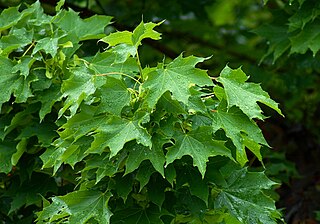
Acer platanoides, commonly known as the Norway maple, is a species of maple native to eastern and central Europe and western Asia, from Spain east to Russia, north to southern Scandinavia and southeast to northern Iran. It was introduced to North America in the mid-1700s as a shade tree. It is a member of the family Sapindaceae.

Acer rubrum, the red maple, also known as swamp maple, water maple, or soft maple, is one of the most common and widespread deciduous trees of eastern and central North America. The U.S. Forest Service recognizes it as the most abundant native tree in eastern North America. The red maple ranges from southeastern Manitoba around the Lake of the Woods on the border with Ontario and Minnesota, east to Newfoundland, south to Florida, and southwest to East Texas. Many of its features, especially its leaves, are quite variable in form. At maturity, it often attains a height around 30 m (100 ft). Its flowers, petioles, twigs, and seeds are all red to varying degrees. Among these features, however, it is best known for its brilliant deep scarlet foliage in autumn.

Maple Ridge is a city in British Columbia, Canada. It is located in the northeastern section of Greater Vancouver between the Fraser River and the Golden Ears, which is a group of mountain summits which are the southernmost of the Garibaldi Ranges of the Coast Mountains. Maple Ridge's population in 2021 was 90,990. Its downtown core area was once known as Haney.

Thymelicus lineola, known in Europe as the Essex skipper and in North America as the European skipper, is a species of butterfly in the family Hesperiidae.

Acer is a genus of trees and shrubs commonly known as maples. The genus is placed in the soapberry family, Sapindaceae, along with lychee and horse chestnut. There are approximately 132 species, most of which are native to Asia, with a number also appearing in Europe, northern Africa, and North America. Only one species, Acer laurinum, extends to the Southern Hemisphere. The type species of the genus is the sycamore maple, Acer pseudoplatanus, the most common maple species in Europe. Maples usually have easily recognizable palmate leaves and distinctive winged fruits. The closest relatives of the maples are the horse chestnuts. Maple syrup is made from the sap of some maple species. It is one of the most common genera of trees in Asia. Many maple species are grown in gardens where they are valued for their autumn colour.

Tabanus lineola, also known as the striped horse fly, is a species of biting horse-fly. It is known from the eastern coast of North America and the Gulf coast of Mexico.
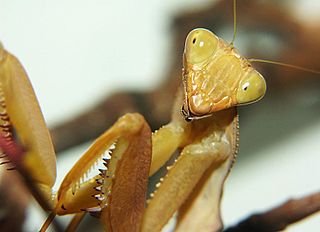
Sphodromantis lineola, common name African mantis or African praying mantis, is a species of praying mantis from Africa sometimes raised in captivity. S. lineola is often colored green, however they can also be colored different types of brown. The brown colored individuals have also been observed with purple colored eyes. It may be distinguished from S. baccettii by the absence of blue-black spots on its forearms.
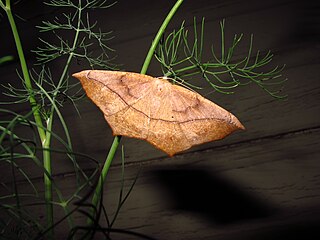
Prochoerodes is a genus of moths in the family Geometridae erected by Augustus Radcliffe Grote in 1883.

Eusarca confusaria, the confused eusarca, is a moth species of the family Geometridae that occurs in North America and Brazil. It is the only member of the genus Eusarca that inhabits the northern portion of the United States and Canada.

Eudonia lineola is a species of moth in the family Crambidae. It is found in Great Britain, Ireland, the Netherlands, France, Spain, Portugal and on Sardinia, the Canary Islands, as well as in North Africa, including Morocco.

Analeptura lineola is a species of beetle in the family Cerambycidae that is found throughout the eastern United States and Canada. It is an anthophilous species, feeding on flower nectar as an adult. In the larval stage, this species bores into the bases of decaying woody plants, including red maple, chestnut, hazelnut, cherry, basswood, viburnum, and laurel.
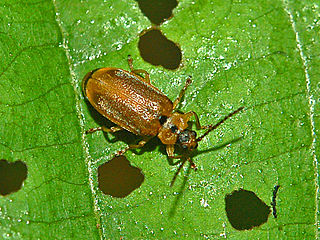
Galerucella lineola is a species of leaf beetle in the family Chrysomelidae.

Prochoerodes amplicineraria is a species of geometrid moth in the family Geometridae. It is found in North America.
Prochoerodes truxaliata is a species of geometrid moth in the family Geometridae.
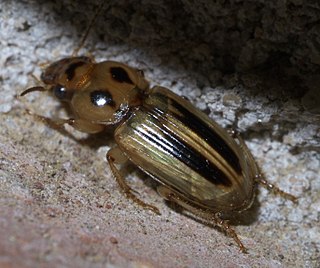
Stenolophus lineola is a species of ground beetle in the family Carabidae. It is found in North America.
Prochoerodes olivata is a species of geometrid moth in the family Geometridae. It is found in Central America and North America.

Prochoerodes forficaria is a species of geometrid moth in the family Geometridae. It is found in North America.

Xanthoparmelia lineola, commonly known as the tight rock-shield, is a foliose lichen species in the genus Xanthoparmelia. It is a common species with a temperate distribution. Found in North America and South Africa, it grows on rocks.


















